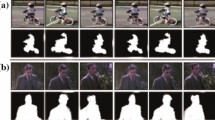Abstract
Multimedia analysis usually deals with a large amount of video data with a significant number of moving objects. Often it is necessary to reduce the amount of data and to represent the video in terms of moving objects and events. Event analysis can be built on the detection of moving objects. In order to automatically process a variety of video content in different domain, largely unsupervised moving object segmentation algorithms are needed. We propose a fully unsupervised system for moving object segmentation that does not require any restriction on the video content. Our approach to extract moving objects relies on a mesh-based combination of results from colour segmentation (Mean Shift) and motion segmentation by feature point tracking (KLT tracker). The proposed algorithm has been evaluated using precision and recall measures for comparing moving objects and their colour segmented regions with manually labelled ground truth data. Results show that the algorithm is comparable to other state-of-the-art algorithms. The extracted information is used in a search and retrieval tool. For that purpose a moving object representation in MPEG-7 is implemented. It facilitates high performance indexing and retrieval of moving objects and events in large video databases, such as the search for similar moving objects occurring in a certain period.











Similar content being viewed by others
References
Antonini G, Martinez SV, Bierlaire M, Thiran JP (2006) Behavioral priors for detection and tracking of pedestrians in video sequences source. Int J Comput Vis 69(2):159–180
Bailer W, Schallauer P (2006) Detailed audiovisual profile: enabling interoperability between MPEG-7 based systems. International Conference on Multi Media Modelling
Bailer W, Schallauer P, Bergur Haraldsson H, Rehatschek H (2005) Optimized mean shift algorithm for color segmentation in image sequences. Image and Video Communications and Processing, pp 522–529
Bailer W, Höller F, Messina A, Airola D, Schallauer P, Hausenblas M (2005) State of the art of content analysis tools for video, audio and speech. Deliverable Prestospace, Homepage: http://www.prestospace.org/project/deliverables/D15-3_Content_Analysis_Tools.pdf
Barron JL, Fleet DJ, Beauchemin SS (1994) Performance of optical flow techniques. International Journal of Computer Vision
Borshukov GD, Bozdagi G, Altunbasak Y, Tekalp AM (1997) Motion segmentation by multistage affine classification. IEEE Trans Image Process 6:1591–1594
Celasun I, Tekalp AM, Gökçetekin MH, Harmancı DM (2001) 2-D mesh-based video object segmentation and tracking with occlusion resolution. Signal Processing: Image Communication Volume 16, Issue 10
Comaniciu D (2002) Mean shift: a robust approach toward feature space analysis. IEEE Transactions on Pattern analysis and machine intelligence
Comaniciu D, Meer P (1997) Robust analysis of feature spaces: colour image segmentation. Department of Electrical and Computer Engineering
Computer Vision Research Group, Department of Computer Science, Homepage: http://www.cs.otago.ac.nz/research/vision, http://of-eval.sourceforge.net/, 1999.
Davis JC (2002) Statistics and data analysis in geology, 3d edn. Wiley
Donoser M (2003) Object segmentation in film and video. Diploma thesis, TU-Graz
Duda RO, Hart PE, Stork DG (2001) Pattern classification. Wiley
Erdem CE, Sankur B (2000) Performance evaluation metrics for object-based video segmentation. Proceedings of the 10th European Signal Processing Conference (EUSIPCO ’00), pp. 917–920, Tampere, Finland
Galić S, Lončarić S (2000) Spatio-temporal image segmentation using optical flow and clustering algorithm. Proceedings of the First International Workshop on Image and Signal Processing and Analysis
Guo J, Kim J, Jay Kuo C-C (1999) New Video object segmentation technique with color/motion information and boundary postprocessing. Applied Intelligence Journal
Heidrich W, Seidel H-P (1999) Realistic, Hardware-accelerated Shading and Lighting. Proceeding of SIGGRAPH 99
Horn BKP, Schunck BG (1980) Determining optical flow. Massachusetts Institute of Technology
Kriechbaum A (2005) Segmentation of moving objects in film and video. Master thesis
Lepetit V, Fua P (2005) Monocular model-based 3D tracking of rigid objects: a survey. Foundations and Trends in Computer Graphics and Vision 1(1):1–89
Lienhart R (2001) Reliable transition detection in videos: a survey and practitioner’s guide. International Journal of Image and Graphics (IJIG) 1(3):469–486
Liu L, Fan G (2005) Combined key-frame extraction and object-based video segmentation. IEEE Trans. Circuits and System for Video Technology
Lucas BD, Kanade T (1981) An iterative image registration technique with an application to stereo vision. International Joint Conference on Artificial Intelligence, pp 674–679
Martinez JM (2002) MPEG-7 overview. International organisation for standardisation
Oh J, Lee J, Vemuri E (2003) An efficient technique for segmentation of key object(s) from video shots. ITCC ’03: Proceedings of the International Conference on Information Technology: Computers and Communications
Rehatschek H, Schallauer P, Bailer W, Haas W, Wertner A (2004) An innovative system for formulating complex combined content-based and keyword-based queries. Proceedings of SPIE-IS&T, Electronic Imaging, vol. 5304, pp 160–169
Tsechpenakis G, Rapatzikos K, Tsapatsoulis N, Kollias S (2003) Object tracking in clutter and partial occlusion through rule-driven utilization of snakes. IEEE International Conference on Multimedia & Expo (ICME)
Wei Z, Jun D, Wen G, Qingming H (2005) Robust moving object segmentation on H.264/AVC compressed video using the block-based MRF model. Real-Time Imaging
Xu N, Ahuja N, Bansal R (2003) Object segmentation using graph cuts based active contours. CVPR03, pp 46–53
Zhang D, Lu G (2001) Segmentation of moving objects in image sequence: a review. Circuits Syst Signal Process 20(2):143–183
Acknowledgements
The authors would like to thank Werner Haas, Werner Bailer and Peter Schallauer as well as several other colleagues at JOANNEUM RESEARCH, who provided valuable feedback. The research leading to these results has received funding from the European Community’s Seventh Framework Programme (FP7/2007-2013) under grant agreement n° 216465 (ICT project SCOVIS).
Author information
Authors and Affiliations
Corresponding author
Rights and permissions
About this article
Cite this article
Kriechbaum, A., Mörzinger, R. & Thallinger, G. A framework for unsupervised mesh based segmentation of moving objects. Multimed Tools Appl 50, 7–28 (2010). https://doi.org/10.1007/s11042-009-0366-9
Published:
Issue Date:
DOI: https://doi.org/10.1007/s11042-009-0366-9




